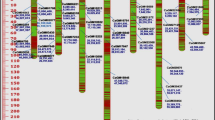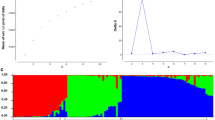Abstract
Assessment of the extent of genetic variability within chickpea is fundamental for chickpea breeding and conservation of genetic resources and is particularly useful as a general guide in the choice of parents for breeding hybrids. To establish genetic diversity among 60 accessions of chickpea comprising landraces, internationally developed improved lines, and cultivars, genetic distances were evaluated using 14 simple sequence repeat markers. These markers showed a high level of polymorphism; a total of 59 different alleles were detected, with a mean of 4.2 alleles per locus. The polymorphic information content (PIC) value ranged from 0.31 to 0.89. All the markers, with the exception of TAA170, TA110, GA34, and Ts35, were considered to be informative (PIC > 0.5), indicating their potential usefulness for cultivar identification. Based on the UNJ clustering method, all accessions were clustered in five groups, which indicated the probable origin and region similarity of Iranian landraces over the other cultivars. It also represents a wide diversity among available germplasm. The result has firmly established that introduction of genetic materials from exotic sources has broadened the genetic base of the national chickpea breeding program. As further implications of the findings, this study can be useful for selective breeding for specific traits and in enhancing the genetic base of breeding programs.



Similar content being viewed by others
References
Botstein D, With RL, Skolnick M, Davis RW (1980) Construction of genetic linkage map in man using restriction fragment length polymorphisms. Am J Hum Genet 32:314–331
Carvalho MA (2004) Germplasm characterization of Arachis pintoi Krap. and Greg. (Leguminosae). PhD Thesis, University of Florida, USA
Chahal GS, Gosal SS (2002) Principles and procedures of plant breeding: biotechnological and conventional approaches. Narosa, New Delhi
Choudhary P, Khanna SM, Jain PK, Bharadwaj C, Kumar J, Lakhera PC, Srinivasan R (2012) Genetic structure and diversity analysis of the primary gene pool of chickpea using SSR markers. Genet Mol Res 11(2):891–905
de Vicente MC, Guzmán FA, Engels J, Rao VR (2005) Genetic characterization and its use in decision making for the conservation of crop germplasm. The role of biotechnology. In: International workshop the role of biotechnology for the characterization and conservation of crop, forestry, animal and fishery genetic resources. FAO, Fobiotech, Ecogene, Siga, Turin, pp 121–128, 5–7 March 2005
Iruela M, Rubio J, Cubero JI, Gil J, Milan T (2002) Phylogenetic analysis in the genus Cicer and cultivated chickpea using RAPD and ISSR markers. Theor Appl Genet 104:643–651
Jannatabadi AA, Talebi R, Armin M, Jamalabadi J, Baghebani N (2013) Genetic diversity of Iranian landrace chickpea (Cicer arietinum L.) accessions from different geographical origins as revealed by morphological and sequence tagged microsatellite markers. J Plant Biochem Biotechnol. doi:10.1007/s13562-013-0206-x
Keneni G, Bekele E, Imtiaz M, Dagne K, Getu E, Assefa F (2011) Genetic diversity and population structure of Ethiopian chickpea (Cicer arietinum L.) germplasm accessions from different geographical origins as revealed by microsatellite markers. Plant Mol Biol Report 30:654–665
Lassner MW, Peterson P, Yoder JI (1989) Simultaneous amplification of multiple DNA fragments by polymerase chain reaction in the analysis of transgenic plants and their progeny. Plant Mol Biol Report 7:116–128
Mekibeb H, Demissie A, Tullu A (1991) Pulse crops of Ethiopia. In: Engels JMM, Hawkes JG, Worede M (eds) Plant genetic resources of Ethiopia. Cambridge University Press, UK, pp 328–343
Métais I, Aubry C, Hamon B, Jalouzot R (2000) Description and analysis of genetic diversity between commercial bean lines (Phaseolus vulgaris L.). Theor Appl Genet 101:1207–1214
Naghavi MR, Jahansouz MR (2005) Variation in the agronomic and morphological traits of Iranian chickpea accessions. J Integ Plant Biol 47:375–379
Nguyen TT, Taylor PW, Redden RJ, Ford R (2004) Genetic diversity estimates in Cicer using AFLP analysis. Plant Breed 123:173–179
Peakall R, Smouse PE (2006) GENALEX 6: genetic analysis in Excel. Population genetic software for teaching and research. Mol Ecol Notes 6:288–295
Perrier X, Flori A, Bonnot F (2003) Data analysis methods. In: Hamon P, Seguin M, Perrier X, Glaszmann JC (eds) Genetic diversity of cultivated tropical plants. Science Publishers, Enfield, Montpellier, pp 43–76
Rubenstein DK, Heisey P, Shoemaker R, Sullivan J, Frisvold G (2005) Crop genetic resources: an economic appraisal. United States Department of Agriculture (USDA). Economic Information Bulletin No. 2. (www.ers.usda.gov)
Saeed A, Hovsepyan H, Darvishzadeh R, Imtiaz M, Panguluri SK, Nazaryan R (2011) Genetic diversity of Iranian accessions, improved lines of chickpea (Cicer arietinum L.) and their wild relatives by using simple sequence repeats. Plant Mol Biol Report 29:848–858
Sefera T, Abebie B, Gaur PM, Assefa K, Varshney RK (2011) Characterisation and genetic diversity analysis of selected chickpea cultivars of nine countries using simple sequence repeat (SSR) markers. Crop Pasture Sci 62:177–187
Singh R, Singhal V, Randhawa GJ (2008) Molecular analysis of chickpea (Cicer arietinum L.) cultivars using AFLP and STMS markers. J Plant Biochem Biotechnol 17:167–171
Talebi R, Fayaz R, Mardi M, Pirsyedi SM, Naji AM (2008a) Genetic relationships among chickpea (Cicer arietinum) elite lines based on RAPD and agronomic markers. Int J Agric Biol 8:1560–8530
Talebi R, Naji AM, Fayaz F (2008b) Geographical patterns of genetic diversity in cultivated chickpea (Cicer arietinum L.) characterized by amplified fragment length polymorphism. Plant Soil Environ 54:447–452
Tanya P, Taeprayoon P, Hadkam Y, Srinives P (2011) Genetic diversity among Jatropha and Jatropha-related species based on ISSR markers. Plant Mol Biol Report 29:252–264
Tessier C, David J, This P, Boursiquot JM, Charrier A (1999) Optimization of the choice of molecular markers for varietal identification in Vitis vinifera L. Theor Appl Genet 98:171–177
Van Der Maesen LJG (1987) Origin, history and taxonomy of chickpea. In: Saxena MC, Singh K (eds) The Chickpea. CAB Inter, Wallingford, pp 11–34
Vavilov NI (1926) Studies on the origin of cultivated plants. Inst Appl Bot Plant Breed, Leningrad
Winter P, Benko-Iseppon AM, Hüttel B, Ratnaparkhe M, Tullu A, Sonnante G, Pfaf T, Tekeoglu M, Santra D, Sant VJ, Rajesh PN, Kahl G, Muehlbauer FJ (2000) A linkage map of chickpea (Cicer arietinum L.) genome based on recombinant inbred lines from a C. arietinum × C. reticulatum cross: localization of resistance genes for Fusarium wilt races 4 and 5. Theor Appl Genet 101:1155–1163
Acknowledgments
We wish to present our special thanks to International Centre for Agricultural Research in the Dry Areas (ICARDA), Aleppo, Syria and Seed and Plant Improvement Institute (SPII) of Iran, Karaj, for kindly supplying seeds of chickpea accessions.
Author information
Authors and Affiliations
Corresponding author
Rights and permissions
About this article
Cite this article
Ghaffari, P., Talebi, R. & Keshavarzi, F. Genetic diversity and geographical differentiation of Iranian landrace, cultivars, and exotic chickpea lines as revealed by morphological and microsatellite markers. Physiol Mol Biol Plants 20, 225–233 (2014). https://doi.org/10.1007/s12298-014-0223-9
Received:
Revised:
Accepted:
Published:
Issue Date:
DOI: https://doi.org/10.1007/s12298-014-0223-9




